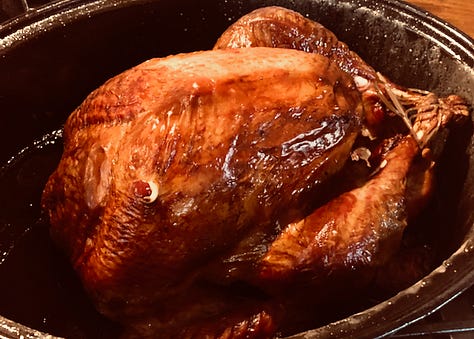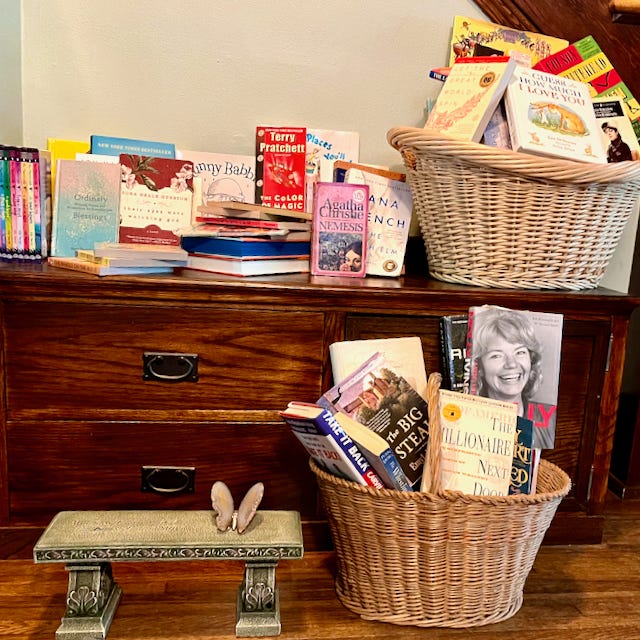I was the cook in the family, until food tried to kill me.
I wasn’t alone. You may know others who have experienced excruciating pain after eating food. Who spent days curled up in bed with heating pads on their bellies; went to five or seven or a dozen specialists; were rushed in ambulances to the ER, or who lost weight — a lot of weight — after eating food. And yet nothing showed up in the tests. Not in the endoscopy, the colonoscopy, the ultrasounds, the labs. When I brought in, um, a full-sized sample (in a white plastic bowl called a “hat,” presumably because it might make a hilarious head covering at a gastroenterologists’ costume party) there was no evidence of blood, suspect bacteria, or parasites. The stomach-emptying test using x-rays and radioactive scrambled eggs revealed . . . nothing. And when specialists have eliminated everything and are left with nothing and it involves the gut, they call it IBS. IBS stands for: Food is out to kill you.
But not all food! It’s those high in what are called FODMAPS that have you in their sights. Fermentable oligo-, di-, mono-saccharides and polyols operate in the dark tunnels of the lower GI. FODMAPS sounds like an international terrorist organization, because it is. This subversive underground of short-chain carbohydrates has one mission: to blow up your gut.
Here’s the FODMAPS manifesto:
https://my.clevelandclinic.org/health/treatments/22466-low-fodmap-diet
And the mastermind: Gluten.
The idea that amber waves of grain might be concealing a Saddam or Osama sounded to the food industry like a marketing opportunity. Think of the billions to be made if, for example:
A manufacturer calls in Seal Team Six. The goal is not to kill the head terrorist, but to slap a label on a package of crackers, then double the price.
A restaurant gives customers a gluten-free option by removing a small baguette before the plate leaves the kitchen, without lowering the cost.
Another place charges an extra two bucks to stick a burger inside a bun that will dissolve when it meets ketchup.
These are things one would expect when the free market meets a new functional disorder. Our grocery bills went up, but I got to eat bread. Dining out became more expensive, but we had a wider choice of options. Two things, however, did not change.
IBS hurt me. It also hurt my husband.

Because each person’s gut is unique, someone with IBS might be able to eat cantaloupe but not watermelon; raspberries and blueberries but not blackberries; pure maple syrup but not imitation; the green tops of scallions but not the white bottoms. Bananas that are barely ripe are fine, but not bananas that have turned soft. Any of these sensitivities can emerge or disappear overnight, or never. An IBS sufferer may be regarded as an attention-seeking child, an adult with a perversely annoying psychiatric condition, or a complete pain in the ass.
It takes an enormous amount of devotion to live with that kind of person.
See the stack of books in the picture at the top of this essay? My husband bought all of them. He studied them. He downloaded the FODMAPS diet app. He removed garlic, beans, apples, cherries, honey, and tequila from shopping lists. I came home from work late at night to find, without fail, the dinner he’d made with my shifting tolerances in mind. I heated those plates and bowls in the microwave and ate them alone. Then I went upstairs to lie next to his sleeping body. He got up at five to catch the light rail to the university where he worked as a librarian. I got up at ten, after two hours in bed wrestling with the choice between going to work or pouring gasoline over my head and lighting a match.
We saw each other on weekends. He’d make dinner.
During this time, his severe rheumatoid arthritis progressed until his hands curled inward like claws. He walked only short distances, always with a cane. In May, 2022, he was diagnosed with the Stage 4 lung cancer that would kill him a year later.
If he had not become a librarian, he said when he retired, he would have become a cabinetmaker. After he died, we took one of the cupboards he’d built in wistful pursuit of that dream. He’d moved it to the basement after one of his kitchen remodels. My son and daughter repurposed it, adding the kind of Craftsman-style details he’d built into our house. They placed it on a post in our front yard. We registered it as an official Little Free Library, and filled it with the books people brought to his Celebration of Life.
Take a book. Share a book. That’s the Little Free Library* motto. But why stop there?



This is what I’m doing this Thanksgiving. What better time to honor the life of a good man?
* https://littlefreelibrary.org/
I became, again, the cook. I was caring for him. He had cared of me. Still, he insisted on coming downstairs to make the tenderloin for our last Valentine’s Day. I opened and closed the oven door, lifted the cast-iron skillet and inserted the meat thermometer. He deglazed the pan with red wine and a sprig of thyme. He added cognac. I turned out the lights. The blue flames erupted, one last time.









Mary- Your journey along with your dearest's across the food map is really inspiring. I've always wondered why information dietary consumption isn't made so much more accessible and widespread---and we'd all have to discover it through painful medical journey. I hope, all things considered, this note is finding you relatively well, Mary? Cheers, -Thalia
As I suspected, your LFL angle was more touching than mine - a nice tribute to your husband, Mary.